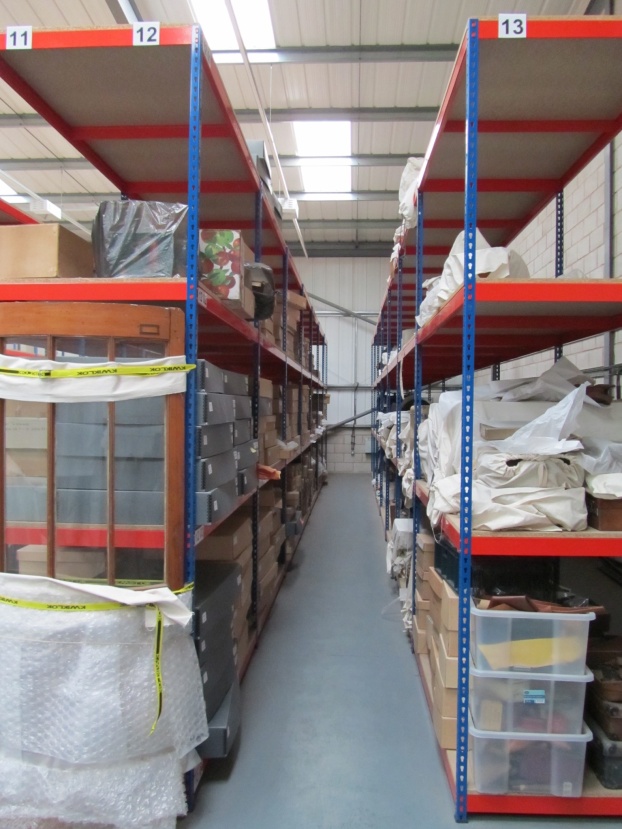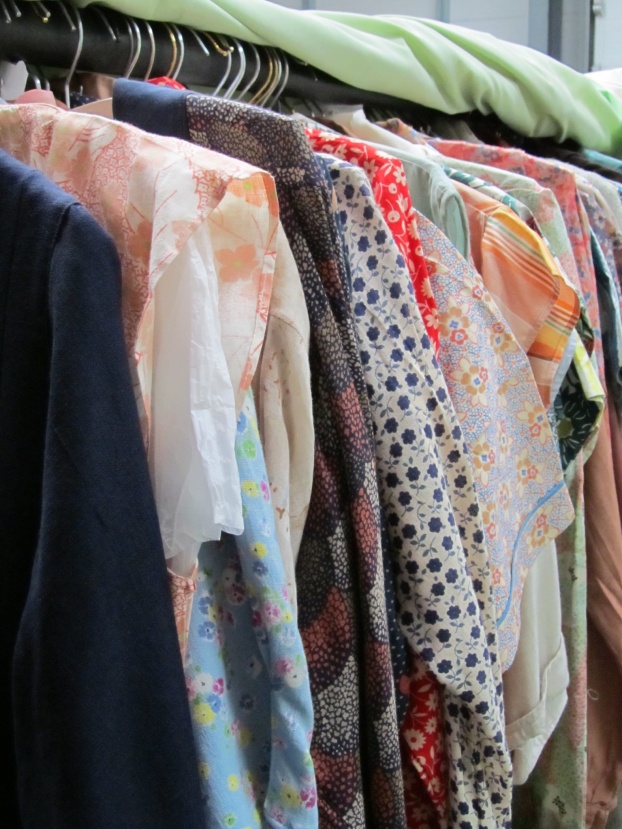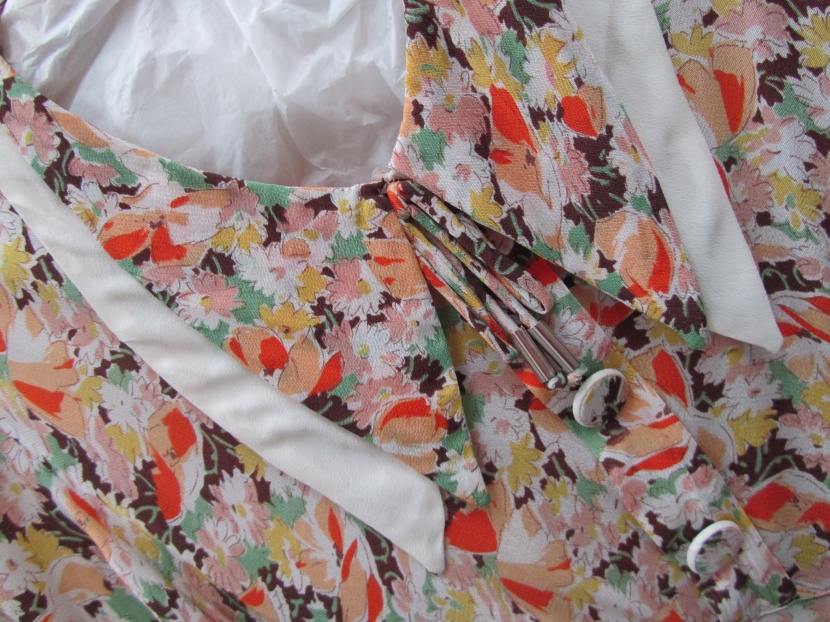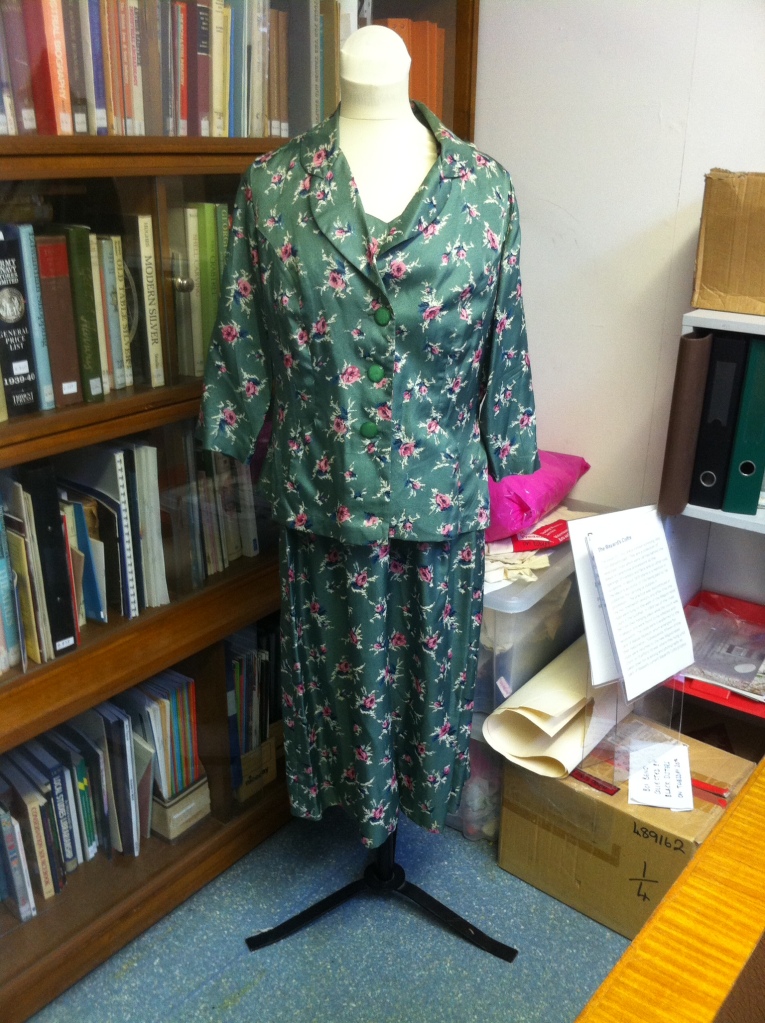Tagged: dress
#InspirationMW and a Fond Farewell
With this being Museums Week, I’ve decided now is a good time to share one of my happiest and most inspiring memories of working with Walsall Museum. Yesterday, people were sharing their museum inspirations on Twitter using the hashtag #inspirationsmw. My museum inspiration started with a visit to Walsall Museum stores back in October 2011.
The museum will close to the public on 31st March 2015. Whilst Walsall Council’s decision to close the museum is saddening, there are reasons to remain positive about the museum’s future. There are plans afoot to move the museum to a new location in 2018 and the Changing Face of Walsall exhibition is being moved to a temporary home at Walsall Leather Museum from 25th July 2015. I’ve also been in discussion with the team regarding pop-up exhibitions. Collections will still be accessible to the public through a range of initiatives – you can find out the full details on the museum’s web page.
As a researcher, I am hopeful that the Hodson Shop Collection (and the rest of the museum’s collection) will continue to be promoted and made available for people to see and study. I’ve seen first hand how people connect with the collection. People can relate to it on a personal level – their mother or grandmother might have worn an apron like that or they had to wear a liberty bodice as a child and can remember the fabric itching on their skin. The Hodson Shop Collection isn’t about spectacle, it is about the everyday things that can often be taken for granted. The things that we don’t expect to find in a museum display but find captivating all the same. Over the two and a half years of this project, I have got to know the collection; without getting too sentimental, it is fair to say that it has found a place in my heart.
It all began back in 2011. I was preparing for my first interview for a PhD studentship and wanted to see the collection up close. I’d never visited a museum store before so I had very little idea of what to expect. I definitely didn’t expect to find myself stood outside a trading estate on the outskirts of Walsall. The building looked like any other anonymous industrial unit, with shutters and a corrugated roof. A forklift truck was buzzing around and there was a constant background clatter of light industry. The surroundings were not in keeping with the treasure trove of twentieth century clothing I had been promised.
Catherine, the museum’s Collections Officer let me in and showed me around. We didn’t know it then but we’d be working together a lot over the coming years. There are plenty of clichés and idioms about judging things by external appearances and I’m going to add another: never judge a museum’s store by it’s exterior. There were shelves stretching from floor to ceiling and aisle after aisle of treasures. The costume collection was stored on a series of calico-covered rails or in boxes stacked down the length of an aisle. Catherine pulled the cover from the Hodson Shop Collection dress rail. The dresses were arranged in age order, starting from the 1920s. I remember being struck by how colourful they were. I was allowed to take out some of the dresses to look at more closely. The first that struck me were the pastel pink and pistachio 1920s dancing dresses with the drop waist and floral corsage. My favourite was a 1930s floral tea dress with a white collar – my first response was ‘there’s something a bit Prada about it’!
There was something magical about opening the boxes and pulling away layers of tissue to reveal the contents. A box of aprons was dazzling, with a riotous mix of prints and gaudy colours. There was the blue and pink wool jersey St Margaret jumper suit, assured in its elegance and (relative) expensiveness to this day. The one thing that has stuck with me in startling clarity was the experience of opening a box of cosmetic items. The smell was overwhelming and instantly familiar – it reminded me of rummaging through my Grandma’s make up bag as a little girl and playing with her frosted pink Avon lipstick. From that point, I knew that I was hooked.
I know that I have been incredibly privileged to get this close to museum items. It is something that I am incredibly grateful to Walsall Museum for. With the closure of the museum, the Hodson Shop Collection will no longer have a display space meaning that the public won’t be able to see the garments. The prospect of the collection being mothballed and kept out of sight is awful. The Hodson Shop Collection has the potential to inspire many, many more people. It needs to be recognised and celebrated as a significant part of not only Walsall’s heritage but of British social and dress history too.
I want to take this opportunity to thank the team at Walsall Museum for their support over the past four years. They have been helpful, knowledgeable and unwavering in their commitment to this project from day one, even when times have been tough.
You can visit Walsall Museum up until Tuesday 31st March. Please show them your support!
Opening hours: Mon-Sat 10am-5pm
Address: Walsall Museum, Lichfield Street, Walsall, West Midlands WS1
Tel: 01922 653116
The Mystery of Morrish & Co.
It all began when I was examining a dress and jacket suit recently accessioned to Walsall Museum’s Community Costume Collection. It was a green crepe ‘sunday best’ style outfit, with a cheery pink rose print. It is from late 1950s or early 1960s (though I could do with doing a bit more research to confirm this). In my more fanciful moments, I can picture Edith or Flora Hodson wearing it whilst bustling off to church or to some family occasion.
Sheila Shreeve found the outfit in a wardrobe at 54 New Road (the property was both the family home and business premises) and there had been some discussion regarding the relationship between the ensemble and the Hodson Shop Collection. The outfit has some very clear signs of wear – soiling around the neckline, evidence of altered hems and repairs and there is even a brooch pinned to the right hand bust. The Hodson Shop Collection is defined as unworn shop stock, with ‘unworn’ being the operative word in this case. Based on the evidence of wear, the outfit was ultimately accessioned into the Community Costume Collection with a note making the relationship to the Hodson Shop clear.
My own study of the garment involved examining the garment inside and out. It was during this process that I noticed the marking under the arms, the repairs in subtly different thread and the clear line of an adjusted hem. I also came across a paper label stitched into the left hand seam of the dress. I can’t find the photo of the label so I will try my best to take one on my next visit to the museum (you can see similar here). From my research notes:
A rectangular paper label is stitched into the left side seam. It is reinforced with a textile mesh on the reverse side. Measures 30mm W x 40mm H. Text is printed in black serif: “MORRISH, LONDON, W1 Ref. C. Style (stamped, red) 194 Prod. (stamped, red) 20035 Mach. (handwritten, pencil) 15 Fin. (stamped, red) 46 Presser Size (stamped, red) 44”
This is where I went wrong. Based on my own experience of clothing labels, I assumed that Morrish were the manufacturers of the outfit. After all, the labels in modern clothing always give the name of the manufacturer, right? This is where the Prownian approach (description, deduction, speculation) to analysing garments proved to be most valuable. It was time to test my hypothesis!
And it turns out that it was very, very wrong. I spent a fascinating afternoon trying to find out who Morrish were. It began, as do many modern adventures in dress history, with a hunt on eBay. I came across several vintage items listed as “Morrish & Co.”, including one rather pretty organza party frock that I came dangerously close to buying (in the name of research, of course). Things got interesting on Etsy where I noticed that listings were far more cautious, referring to ‘order labels’ bearing the name Morrish & Co., as opposed to the stating the company as the manufacturers of the garments. Lots of the garments I came across were listed as appearing to be handmade and there was no real continuity in their style (a sweet party frock one minute, a leopard print-lined leather coat the next). The next phase of my online odyssey took me to an entry on a Vintage Fashion Guild forum. A user called ‘Leonardo da Vintage’ was enquiring about a 50s wiggle dress baring a very similar label. She asked the following questions:
It has a paper hand written label sewn into a seam – what does that indicate? I’ve looked up Morrish & Co, London W1, and the only possibly relevant company made stationary, bags and then shop fittings – so perhaps they made the label, rather than the dress?
Maybe Morrish & Co. weren’t clothing manufacturers after all? Armed with the company name and postcode I decided to search through some trade directories. I hit gold in the Post Office London Directory, 1915 (you can access them via University of Leicester’s wonderful Special Collections Online ‘Historical Directories of England and Wales’) . Listed under ‘PRI’ (which is possibly short for ‘Printers’?) on page 471 I found the following entry :

The listing for Morrish & Co in the 1915 Post Office London Directory. Image via University of Leicester Special Collections Online
I then Googled ‘Morrish & Co 56 Great Titchfield Street’ and the first result was for a company called Morplan. Morplan are suppliers to the fashion industry – they provide labels, ticketing, bags and hangers amongst numerous other bits and pieces essential to clothing retail and manufacture. The ‘About’ page of the website informed me that the ‘Mor’ part of the name was taken from Mr Morrish of Camberwell, SE London who founded the company in 1845. They operated using the names ‘Morrish and Chalfont’, ‘ Morrish & Co.’, ‘Morrish’ and finally ‘Morplan’. They have been operating from Great Titchfield Street, W1 since approx. 1894.
So there’s one mystery pretty much solved: Morrish & Co. made the labels NOT the dresses. I’m not sure how much of this is common knowledge within dress history and vintage circles but it is clearly a red herring that catches many vintage sellers and students like me out. As one mysterious case closes, another one has opened: who made the green ‘Sunday Best’ outfit? I can see this turning into a mammoth trawl through the Hodson Shop Archive. I’ll let you know when I find anything out!
I’m also now beyond intrigued in the history of Morrish & Co. and their links with the fashion industry. Please let me know if you are aware of any research on them. I’ve never really stopped to think about who makes the labels in my clothing, they are one of those small and largely ignored parts of everyday life and dress. There’s a nice project in that somewhere!
Current Exhibition: Red! @ Walsall Museum

From left: printed cotton day dress, c.1951 (Hodson Shop Collection), red grosgrain short evening dress with roses, c.1958.
Sometimes it is the simplest ideas that prove to be the most effective, as evidenced by Walsall Museums latest dress exhibition: Red!
As you might have figured from the title, the exhibition is a celebration the colour red, most specifically the iconic red dress.
All of the dresses have been drawn from Walsall Museum’s massive costume collection and include several items from the Hodson Shop Collection. The dresses are organised in chronological order, starting with this stunning striped muslin day dress from the 1850s (pictured below) and working their way up to this slinky satin wrap dress from the early 1990s (I love the fact that this dress is from Etam). And somewhere in the middle is this grosgrain Wishick and Webber stunner from 1958 (pictured top right).
Hodson Shop dresses include a 1920s cotton day dress with a pointed collar and daisy print, aCC41 (utility) rayon crepe dress with a belt and button details and a 1950s floral print day dress, scattered with stripes and roses (pictured top left). Even though the Hodson dressed are far from the glitziest items on display, they certainly manage to hold their own amongst the frills and flounces.
The visual impact of the colour is undeniable, whether the dress is a glitzy beaded flapper number or a simple utility dress. It is a great starting point for planning outfits for the upcoming party season!
Red! runs until 18th January 2014 at Walsall Museum, Changing Face of Walsall Gallery on the first floor of the Walsall Central Library building. Admission is free! See What’s On Walsall for more details.
The ‘Tinkerbell’ Dress and Exhibiting the Unexhibitable
Since starting this project, I’ve spent a lot of time thinking about dirt and decay. Most specifically the importance of dirt in creating a ‘biography’ for museum garments and the curatorial and conservational challenges it poses.
Here’s the deal: when the Hodson Shop Collection was first discovered, it was dirty. Years of accumulated Black Country grime had taken its toll and left garments smeared with sooty smudges. Yet the decision was made to preserve this grime where possible as it was considered an important part of the collection’s story.
In the absence of a conventional ‘story’, i.e. one that involves someone actually wearing the garments and leaving traces and imprints of wear (this could be a scent, creases or marks), such a decision makes sense. Fashion historians and costume conservators often talk of ‘sacred dirt’ – a lipstick trace here, a spot of blood there. These are marks that are integral to the story of the garment and must be kept intact.
There are some quite touching and intriguing examples of ‘sacred’ dirt within the Hodson Shop Collection. My personal favourite is the 1930s vest that features two small cat paw prints. I love the idea of a cat crawling over the piles of unsold underwear before snuggling down to sleep on a pile of knickers!
So, yes, I find dirt very interesting! But do museum audiences share my interest or do dirt and decay present insurmountable barriers for museum visitors? How can dirt and decay be presented to museum visitors? And at what point does a dirty and decayed item become unexhibitable?
This brings me on to what I have decided to call the ‘Tinkerbell’ dress (pictured above). The name comes from the fact that it is A) green and B) falling into a state of fairy-like shredded decay. It is an item that inhabits a state of limbo, being at once inside a museum but not part of the museum’s collection.
It is a beautiful pale green silk-chiffon dress from the 1920s that was found amongst the Hodson Shop stock. It has long lace-trimmed sleeves, a high lace collar and pretty scalloped pockets made from tiers of lace. I’m was initially quite surprised that the dress was from The Hodson Shop, mainly because it is silk, very bright and involves intricate detailing – such as the clusters of tiny silk wrapped balls that sit on the lace pockets. Most of the early Hodson Shop dresses are cotton or man-made fibres, fairly drab and simple. Sheila Shreeve believes that the dress may have been bought in especially for a friend or family member, thus explaining these differences.
The dress was discovered in such poor condition that it was decided not to accession it into the Hodson Shop Collection. The silk is shattered and shredding – so much so that I was terrified to move the dress to take a picture (hence the far from ideal images above – I’ll attempt to get a better one when I am next at the museum). Whilst this decay is sad, the dress is beautiful.
During her inaugural lecture at London College of Fashion, Amy de la Haye talked about exhibiting fragmentary and shattered garments, in relation to the Fashion and Fancy Dress exhibition of the Messel Family dress collection at Brighton Museum in 2005. According to de la Haye, fabric’s natural ability to ‘disintegrate with the progress of time’ reflects our own human fragility. She gave a wonderful quote from Anne Messel: ‘Their frailty is their magic, don’t you think?’
It was this thinking that lead to the inclusion of a shattered and fragmentary dress in the exhibition. It was laid flat – with its damage and decay exposed to visitors. It was ‘the unexhibitable exhibited’.
Interestingly, an image of a shattered corset worn by Maud Messel was used as the invite for de la Haye’s lecture (see below), suggesting that decayed garments can often make a lasting impression upon on those who come into contact with them.
Unlike the shattered Messel dress, the Tinkerbell dress has not been worn and it is not attached to an illustrious family of aristocratic fashion collectors. Maybe it is wear and attachment to a personality that make signs of decay palatable to museum visitors – are they what enable the unexhibitable to be exhibited?
Whilst the Tinkerbell dress is unlikely to ever be exhibited or accessioned, it has provided me with a lot to think about. I feel very lucky to have experienced this dress in all of its magic frailty.








